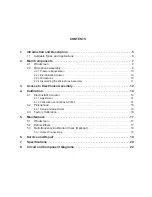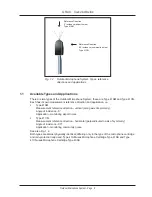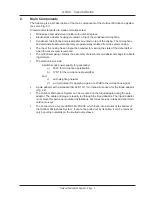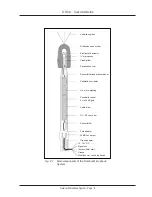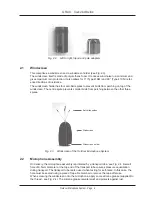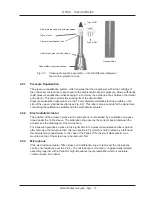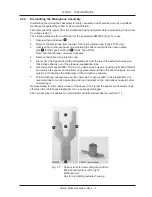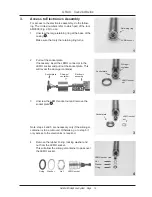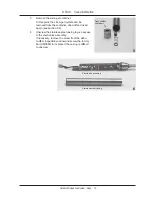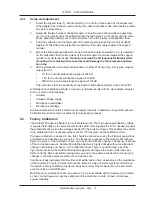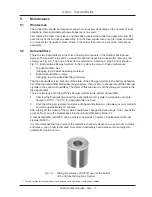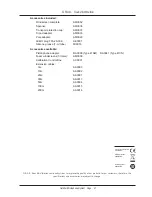
Outdoor Microphone System - Page 14
G.R.A.S. Sound & Vibration
4. Calibration
4.1
Electrostatic Actuator
The Outdoor Microphone System is equipped with a built-in electrostatic actuator to enable
rapid calibration checks
in-situ
. The electrostatic actuator is factory adjusted to simulate a sound
level of 90 dB at a frequency of 1000 Hz on the diaphragm of the microphone (94 dB is also
available on order). The electrostatic actuator is switched on by connecting pin 1 to pin 6 on the
LEMO socket (see Fig. 5.2). This will cause a calibration signal of 500 Hz AC to be applied to
the actuator.
Warning!
do not touch the actuator while the calibration signal is applied. The voltage applied
to the actuator is approximately 300 V RMS.
Extreme care
should be taken when handling the
circuit boards while the power is on. High voltages are present!
The 500 Hz signal creates an oscillating electrostatic field which causes the diaphragm of the
microphone to oscillate at twice the applied frequency thus generating a reference signal of
1000 Hz. The result is a simulated sound pressure on the diaphragm of the microphone which is
directly proportional to the applied voltage and inversely proportional to the spacing between the
actuator surface and the microphone diaphragm.
It can be shown that this method of calibration relates directly to simple absolute physical
parameters.
The stability of this method ensures that the microphone calibration is consistent; therefore no
other calibration check is necessary. Electrostatic actuator calibration should be carried out at
regular intervals.
4.1.1 Adjustment
With the electrostatic actuator switched on, adjust P201 (see Fig. 8.3) to give a signal output
level of 31.6 mV.
An electrostatic-actuator calibration is referred to a Pistonphone calibration as described in sec
-
tion 4.2.1 and assumes that the Outdoor Microphone System has a sensitivity of 50 mV/Pa. In
turn, this means that an output level of 31.6 mV will correspond with 90 dB as simulated by the
electrostatic actuator.
A-Weighting
At this stage, the A-weighting network can also be checked as follows:
1. Move the “Jumper for response” (see Fig. 8.3) from
Lin
to
A-w
.
2. With the electrostatic actuator switched on, adjust P101 (see Fig. 8.3) to give a signal
output level which corresponds with 90 dB, i.e. 31.6 mV.
3. Move the “Jumper for response” back to the position
Lin
.
Position
Com
is not used.
4.1.2 Calibration Control Box AC0001
A useful accessory available from G.R.A.S. is the Calibration Control Box AC0001 (see
Fig. 4.1). This has a lead which plugs directly into the output socket of the Outdoor Microphone
System. The AC0001 has sockets for signal output, remote-control calibration and external
power (12 – 18 V DC, e.g. from a G.R.A.S. Mains/line Adapter AB0002/AB0003*). It also has an
on/off switch for local calibration control.
* AB0002 for 230 V AC; AB0003 for 120 V AC




